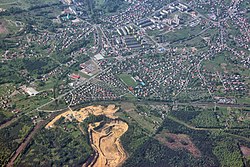Libiąż
Libiąż | |
|---|---|
 Aerial view | |
 Coat of arms | |
 Libiąż | |
| Coordinates: 50°6′N 19°19′E / 50.100°N 19.317°ECoordinates: 50°6′N 19°19′E / 50.100°N 19.317°E | |
| Country | |
| Voivodeship | Lesser Poland |
| County | Chrzanów |
| Gmina | Libiąż |
| Government | |
| • Mayor | Jacek Latko |
| Area | |
| • Total | 35.88 km2 (13.85 sq mi) |
| Population (2006) | |
| • Total | 17,604 |
| • Density | 490/km2 (1,300/sq mi) |
| Time zone | UTC+1 (CET) |
| • Summer (DST) | UTC+2 (CEST) |
| Postal code | 32-590 |
| Car plates | KCH |
| Website | http://www.libiaz.pl |
Libiąż [ˈlʲibʲɔ̃ʂ] is a town in Chrzanów County, Lesser Poland Voivodeship, Poland, with 17,671 inhabitants (2004).
Location[]
Libiąż it located in the eastern part of the Upper Silesian Industrial District. It belongs to the Upper Silesian conurbation, among others, according to the program ESPON. Residents are employed in the central conurbation centers, including in Katowice and Tychy.
Geographically, the city lies on the eastern part of the Silesian Upland, on stromal Pagórach Libiąskich parts Pagórów Jaworzno.[1] The territory of the city is covered by the exploitation of coal.
History[]
The first historical mention of Libiąż comes from the "Chronicles" Jan Dlugosz. It concerns the transfer in the year 1243 the village Libiąż Great and Small Libiąż possession of the Order of the Benedictines by the current owners from the Gryfitów family. In the course of its development Libiąż passed successively in the possession of various families.
After the division of Polish districts in 1138 it belonged to the Duchy of Racibórz, and from the fourteenth to the sixteenth century to the Duchy of Auschwitz, the same to the Czech state. In 1564 years it was absorbed by the Polish Kingdom. In 1795 it got included in the Austrian partition. In the interwar period in the Kraków Voivodeship.
Libiąż was founded by the Count of Wielopolski in 1735. Until the nineteenth century Libiąż was a typical agricultural settlement. Construction of the railway line from Kraków - Vienna had caused migration and settlement of the population in these areas.
The turning point in the history of Libiąż came when rich deposits of coal in the late nineteenth century. At the beginning of the 20th century, the construction of a Janina Coal Mine, which since 1907 operates to this raw material. This has opened up new prospects for Libiąż. The local inhabitants were given jobs, and the town began to be attractive also for people from the outside. From that moment began a rapid economic and cultural development of the settlement. They came skilled workers and a lot of intelligence. At this time, it changed the shape urban Libiąż. Around the mine began to form a new residential and public buildings (schools , post office and telegraph).
According to the Austrian census of 1900 in Libiąż the Great in 258 buildings inhabited by 1,452 people, all Polish-speaking, of which 1,435 Catholics, 17 Jews, in the Libiąż Little in 283 buildings inhabited by 1,557 people, including 1,546 Polish-9 German and 2 others, the 1,522 Catholics, 33 of the Jewish faith, and 2 Greek Catholics, and Moczydlo 59 houses inhabited by 283 Polish-speaking, including 279 Catholics, and 4 people of the Jewish faith.
Even after the First World War, when Poland regained independence lasted for the further development of urban and economic development. There are new routes, power line and public buildings. The interwar period is also a time of strong development of the local government.
The outbreak of World War II and the invasion in the wake of the German troops of the German occupation administration in a relatively short time stopped the operation of the main plant in Libiąż, mine "Janina", which in the first half of September 1939. Took extraction. In the period September 1943 - January 1945 to work here subcamp of Auschwitz Janinagrube also called Gute Hoffnung;[2] prisoners performed work on mining coal mine "Janina" in the sub-camp there were more than 800 people. During the occupation, around intensive armed branch of the People's Army led them. Jaroslaw Dabrowski.[3]
The period of the Second World War and the first post-war years hampered the social activity and self-government. Only the further development of the mine "Janina" caused a renewed influx of people to the area. This resulted in obtaining in 1969 the city rights by settlement Libiąż Small and change its name to Libiąż.[4] The city absorbed the village Libiąż too great.
Currently, the cities and villages of Gmina Libiąż include the city of Libiąż itself and two village councils, Żarki and Gromiec.

Janina Mines 1930
Janina Mines 1939

Trenches in Libiąż just before the Second World War (1939)

Janina Mines 2006
References[]
- ^ http://geosilesia.us.edu.pl/301,geoslask__jednostki_geomorfologiczne__wyzyny_slasko-malopolskie.html
- ^ Artur Hojan & Cameron Munro (2017), Camp: Janinagrube / Gute Hoffnung, Obieżowa Colony, Libiąż.
- ^ Joseph Boleslaw Garas' agencies the People's Guard and People's Army 1942 - 1945 "Publisher MON 1971 pp. 420-422.
- ^ "Rozporządzenie Prezesa Rady Ministrów z dnia 8 czerwca 1968 r. W sprawie utworzenia i zmiany granic niektórych miast w województwie krakowskim".
External links[]
- Jewish Community in Libiąż on Virtual Shtetl
- Cities and towns in Lesser Poland Voivodeship
- Chrzanów County





